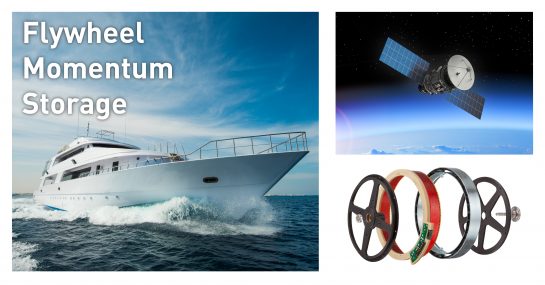For many years, ThinGap motors have been successfully used in a variety of flywheel applications, ranging from gyro-stabilization in boats and satellites, to momentum storage for renewable energy. ThinGap’s TG Series of slotless motor kits are ideal for flywheel applications because of their highly efficient lightweight composite stator, optimal balance between torque and inertia, with negligible rotational losses, and zero cogging that is critical to achieving smooth motion at high speed.

Boats of all sizes stand to benefit from gyroscopic stabilization. Due to Newton’s third law of motion – every action carrying an equal and opposite reaction, a gyroscopes motion can be used to stabilize a ship or boat in heavy seas. A marine gyro-stabilizer is a large, spinning flywheel housed in the depths of the ship, near the keel. As the flywheel spins, computers on the bridge orient the flywheel against the ships current rolling motion, cancelling it out. ThinGap’s high efficiency motors make an excellent flywheel stabilizer of all sizes and can withstand harsh marine environments.
Another application where gyroscopic flywheels are used to change orientation is with satellites and their use of Reaction Wheel Assemblies. Yet another case of Newton’s Third Law, when a reaction wheel is spun up inside a satellite, the spacecraft turns in the opposite direction of the flywheel’s rotation, with this being used to steer and orient spacecraft in orbit. Because motion in space is multi-axial, each satellite carries multiple reaction wheels in an assembly to freely rotate. Since 2015, ThinGap has shipped thousands of kits for reaction wheel assemblies in large commercial and Government funded constellations, and in 2022, spun off their reaction wheel assembly motor kits to a separate product line.
An emerging use for highly efficient slotless motor kits is in momentum storage. Pioneered more than a decade ago for motorsports applications, excess or available energy is transferred to a motor that spins up a flywheel, whereby storing that energy in a rotating mass as a mechanical battery, instead of as chemical energy. Advantages of retaining the energy in a momentum flywheel application includes high power density compared with conventional batteries for quicker charge and discharge. Future applications of momentum storage could even extend to emerging markets such as renewable energy.
ThinGap’s ironless stator puts all the magnetics, the heaviest part of the motor, in the rotor. This maximizes the inertia for a given weight and size requirement, meaning the necessary flywheel mass can be reduced, and sometimes fully incorporated into the rotor, resulting in a lighter weight package for the same momentum storage capacity. Due to no iron saturation in the stator, ThinGap’s peak torque capacity is much higher for a similar weight motor, giving a dynamic response significantly better than the competition at a lighter weight.
To learn more about ThinGap’s TG Series of motor kits, click here.
